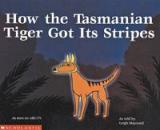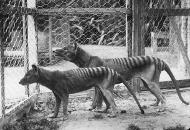AustLit
Latest Issues
AbstractHistoryArchive Description
One day Palana, the son of the great god Moinee, is out hunting. He begins to track a big kangaroo called Tarna. Tarna hides behind a tree and attacks Palana when he comes close. Only a young pup hears Palana's cries for help and runs to the rescue.
Affiliation Notes
-
Thylacines and the Anthropocene
In How the Tasmanian Tiger Got Its Stripes, Leigh Maynard recounts a Dreaming story from the Nuenonne nation of Bruny Island about a young pup who rescues the boy-god Palana from Tarna, the Great Kangaroo. In recognition of his courage, Palana marks the pup with healing stripes made from his blood and spiritual power mixed with campfire ash. This transforms the pup into a thylacine, and aligns him with the great spirit and constellation Wurrawana-Corinna.
An animated retelling of this story, as told by Maynard, was screened by the ABC as 'Kannenner the Brave (The Tasmanian Tiger)'.
Maynard's retelling shares key details with another Dreaming story, 'Corinna, The Brave One' as told by Timler and attributed to Mannalargenna, the leader of the Pairrebeenne clan in lutruwita / Tasmania's north-east. This story was first recorded in the Cotton family's collection of palawa and pakana narratives from the 1830s—later published as Touch the Morning: Tasmanian Native Legends (1979)—and includes terms like 'baptism' and 'Tiger', which may suggest some narrative intervention by the settler family (Owen). The Tasmanian Aboriginal Centre, for instance, questions the folkloric license taken by settler-ethnographers, overwriting First Nations voices and knowledges with European perspectives.
These Dreaming stories—and other mainland presences, such as art from Kuninjku Country and stories from Arrenrnte Country—demonstrate how despite the thylacine's extinction, there was and remains a diversity of relationships between the thylacine and First Nations peoples in Australia.
This work is affiliated with the Thylacines and the Anthropocene dataset, tracking thylacine extinction and ecological themes in Australian literature.
Publication Details of Only Known VersionEarliest 2 Known Versions of
Works about this Work
-
Untitled
2004
single work
review
— Appears in: Reading Time : The Journal of the Children's Book Council of Australia , November vol. 48 no. 4 2004; (p. 22)
— Review of How the Tasmanian Tiger Got Its Stripes 2004 single work picture book
-
Untitled
2004
single work
review
— Appears in: Reading Time : The Journal of the Children's Book Council of Australia , November vol. 48 no. 4 2004; (p. 22)
— Review of How the Tasmanian Tiger Got Its Stripes 2004 single work picture book





